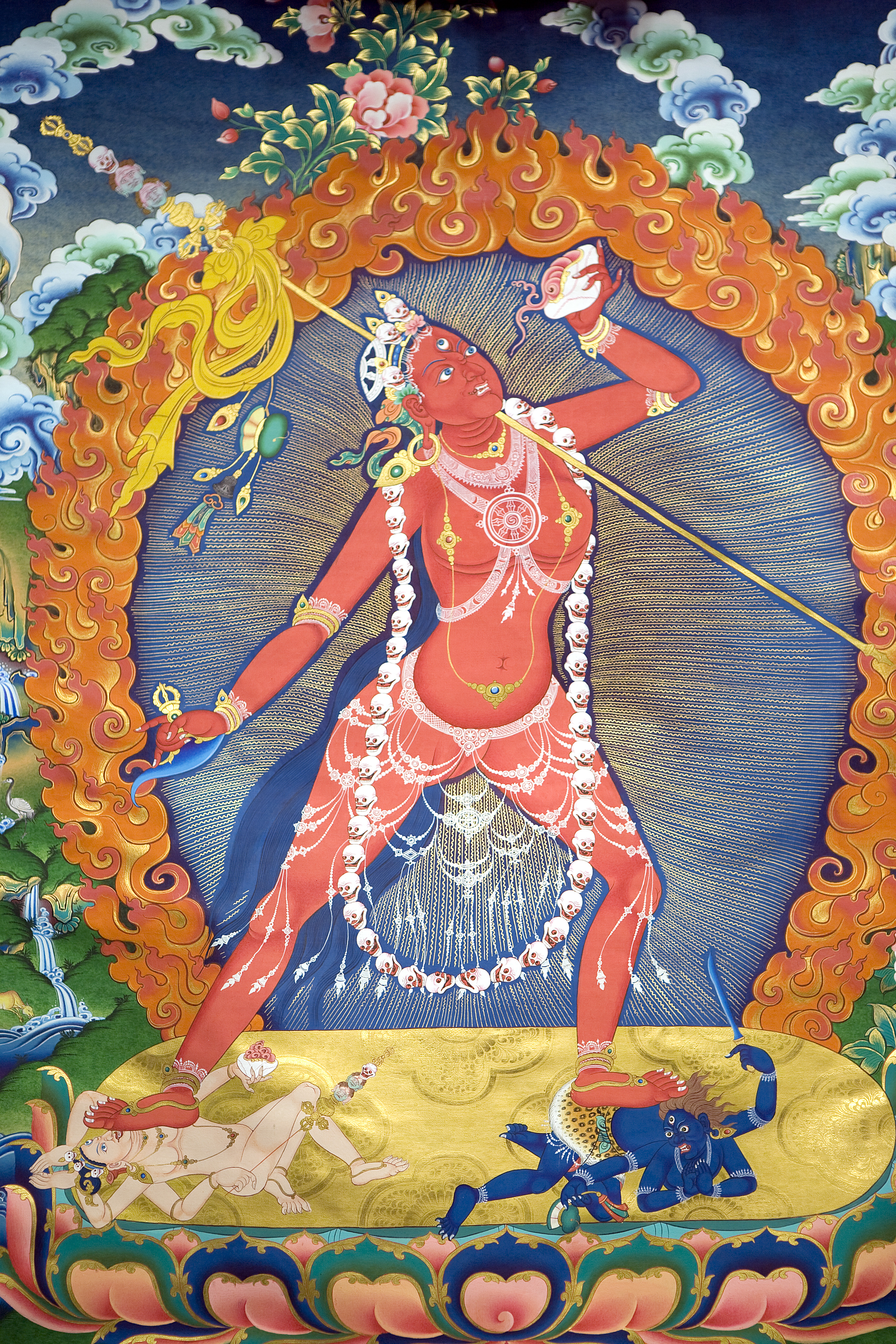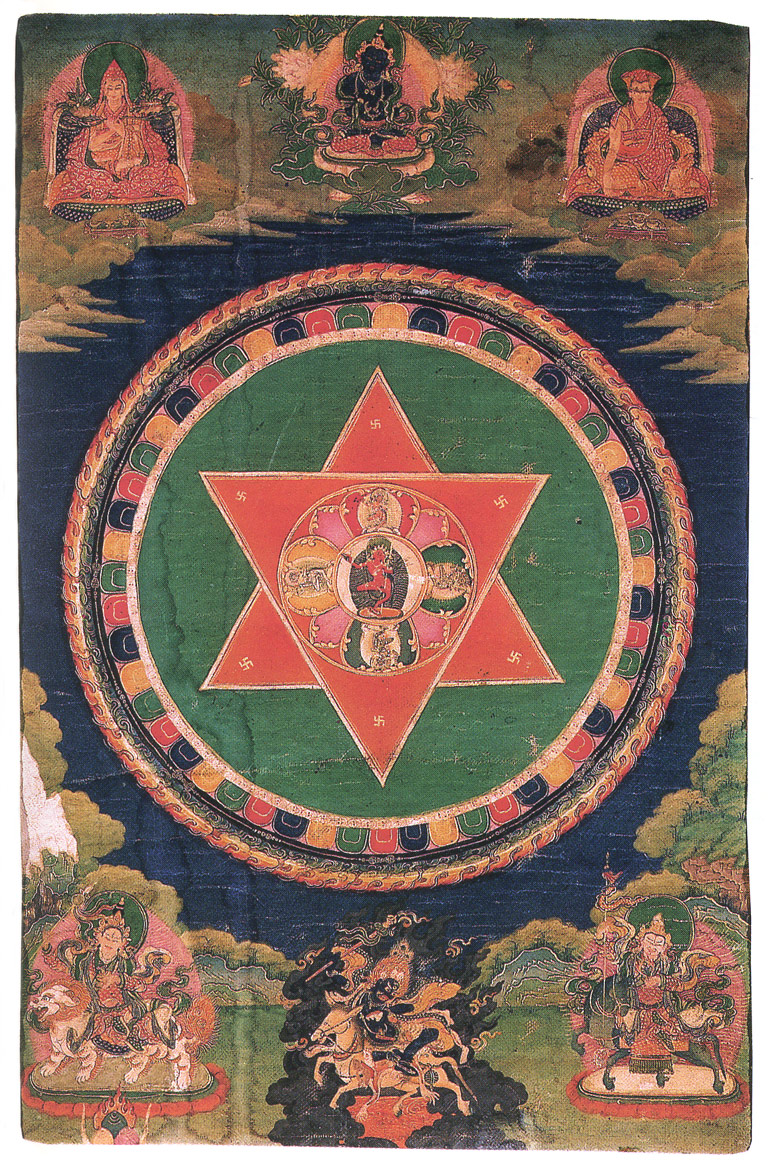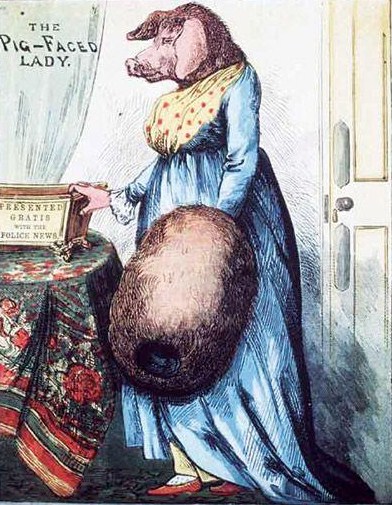|
Vajravārāhī
In Tibetan Buddhism, Vajravārāhī ("The Diamond Sow", Dorje Pakmo) is a wrathful form of Vajrayogini associated particularly with the ''Cakrasaṃvara Tantra'', where she is paired in yab-yum with the Heruka Cakrasaṃvara. Judith Simmer-Brown writes that "Vajravārāhī's iconography is very similar to that of Vajrayoginī, but she often has more prominent fangs and a more wrathful expression, and she prominently displays a sow's head above her right ear." Although there are practices of Vajravārāhī in all schools of Tibetan Buddhism, she is particularly associated with the Kagyu school and is one of the main yidam practices of that school. Her tulkus, the Samding Dorje Phagmo, are associated with the Bodongpa, a little-known school of Tibetan Buddhism. Iconography Vajravārāhī is one of the most popular female Tantric deities in all traditions of Tibetan Buddhism. Although there are several forms, the basic iconography is that she has one face, (usually) two hands an ... [...More Info...] [...Related Items...] OR: [Wikipedia] [Google] [Baidu] |
Vajrayogini
Vajrayoginī ( sa, italic=yes, Vajrayoginī वज्रयोगिनी; , Dorjé Neljorma; mn, Огторгуйд Одогч, Нархажид, ) is a Tantric Buddhist female Buddha and a . The ''Vajrayogini'' cult dates back to the tenth and twelfth centuries. Vajrayoginī's essence is "great passion" (''maharaga''), a transcendent passion that is free of selfishness and illusion—she intensely works for the well-being of others and for the destruction of ego clinging. She is seen as being ideally suited for people with strong passions, providing the way to transform those passions into enlightened virtues. She is an Anuttarayoga Tantra iṣṭadevatā (meditation deity) and her practice includes methods for preventing ordinary death, intermediate state (bardo) and rebirth ( samsara) by transforming them into paths to enlightenment, and for transforming all mundane daily experiences into higher spiritual paths. Practices associated with her are Chöd and the Six Yogas of ... [...More Info...] [...Related Items...] OR: [Wikipedia] [Google] [Baidu] |
Chökyi Drönma
Chökyi Drönma (1422-1455) was a Tibetan princess and Buddhist leader. She was the main consort of Thang Tong Gyalpo, who recognized her as an emanation of Machig Labdrön through the lineage of Vajravārāhī and appointed her as the first Samding Dorje Phagmo. Biography Chökyi Drönma was born in 1422 as the daughter of Thri Lhawang Gyaltsen, the king of Mangyül Gungthang. In 1438 she married a prince from the Southern Tibetan Kingdom of Lato in order to create an alliance between Gungthang and Lato. In 1440, she gave birth to a daughter. When her daughter was old enough to begin schooling, Drönma negotiated with her husband to have her educated according to Buddhist principals. A few years later she returned to Gungthang with an army to assist in an on-going conflict. While she was away her daughter died. After her death, Drönma formally announced her desire to take religious vows, to which her family refused. She became a student of Thang Tong Gyalpo and, eventually, ... [...More Info...] [...Related Items...] OR: [Wikipedia] [Google] [Baidu] |
Samding Dorje Phagmo
The Samding Dorje Phagmo () is the highest female incarnation in Tibet''The Power-places of Central Tibet: The Pilgrim's Guide'', (1988) p. 268. Keith Dowman. . and the third highest-ranking person in the hierarchy after the Dalai Lama and the Panchen Lama. She was listed among the highest-ranking reincarnations at the time of the 5th Dalai Lama, recognized by the Tibetan government and acknowledged by the emperors of Qing China. In her first incarnation, as Chökyi Drönma (1422 CE–1455 CE), she was the student and consort of the famous polymath Thang Tong Gyalpo, who first identified her as an emanation of Vajravārāhī, and the consort of Bodong Panchen. The seat of the Samding Dorje Phagmo is at Samding Monastery, in Tibet. History and background The seat of the Samding Dorje Phagmo is at the Samding Monastery "Temple of Soaring Meditation." The Samding Monastery is associated with the Bodong school of Tibetan Buddhism. It was unique because half of the inhabitants were ... [...More Info...] [...Related Items...] OR: [Wikipedia] [Google] [Baidu] |
Cakrasaṃvara Tantra
The ''Cakrasaṃvara Tantra'' (, ''khorlo demchok,'' The "Binding of the Wheels" Tantra) is an influential Buddhist Tantra. It is roughly dated to the late eight or early ninth century by David B. Gray (with a ''terminus ante quem'' in the late tenth century). The full title in the Sanskrit manuscript used by Gray's translation is: ''Great King of Yoginī Tantras called the Śrī Cakrasaṃvara'' (''Śrīcakrasaṃvara-nāma-mahayoginī-tantra-rāja''). The text is also called the ''Discourse of Śrī Heruka'' (''Śrīherukābhidhāna'') and the ''Samvara Light'' (''Laghusaṃvara''). "Cakrasaṃvara" may also refer to the main deity in this tantra as well as to a collection of texts or "cycle" associated with the root Cakrasaṃvara tantra. Tsunehiko Sugiki writes that this "Cakrasaṃvara cycle", "is one of the largest collections of Buddhist Yoginītantra literature from the early medieval South Asian world."Sugiki, Tsunehiko. Review of ''David B. Gray, The Cakrasamvara Tantra ... [...More Info...] [...Related Items...] OR: [Wikipedia] [Google] [Baidu] |
Thang Tong Gyalpo
Thangtong Gyalpo () (1385 CE–1464 CE or 1361 CE–1485 CE), also known as Chakzampa, the "Iron Bridge Maker" (), Tsöndrü Zangpo "Excellent Persistence" (), and the King of the Empty Plain.Sarah Harding. Niguma, Lady of Illusion. Snow Lion Publications. 2010. p. 265, n. 84 He was also known by a variation of this name, Madman of the Empty Valley. He was a great Buddhist adept, a Chöd master, yogi, physician, blacksmith, architect, and a pioneering civil engineer. He is considered a mind emanation of Padmasambhava and a reincarnation of Dolpopa Sherab Gyaltsen. He founded the Iron Chain lineage of the Shangpa Kagyu school of Tibetan Buddhism, and he recognized the first Samding Dorje Phagmo, Chökyi Drönma (1422–1455), the female incarnation lineage of Vajravārāhī. Thangtong Gyalpo is said to have built 58 iron chain suspension bridges around Tibet and Bhutan, several of which are still in use today. He also designed and built several large stupas of unusual design ... [...More Info...] [...Related Items...] OR: [Wikipedia] [Google] [Baidu] |
Pig-faced Women
Legends featuring pig-faced women originated roughly simultaneously in Holland, England and France in the late 1630s. The stories tell of a wealthy woman whose body is of normal human appearance, but whose face is that of a pig. In the earliest forms of the story, the woman's pig-like appearance is the result of witchcraft. Following her wedding day, the pig-faced woman's new husband is granted the choice of having her appear beautiful to him but pig-like to others, or pig-like to him and beautiful to others. When her husband tells her that the choice is hers, the enchantment is broken and her pig-like appearance vanishes. These stories became particularly popular in England, and later in Ireland. The magical elements gradually vanished from the story, and the existence of pig-faced women began to be treated as fact. The story became particularly widespread in Dublin in the early 19th century, where it became widely believed that reclusive 18th-century philanthropist Griselda ... [...More Info...] [...Related Items...] OR: [Wikipedia] [Google] [Baidu] |
Kagyu
The ''Kagyu'' school, also transliterated as ''Kagyü'', or ''Kagyud'' (), which translates to "Oral Lineage" or "Whispered Transmission" school, is one of the main schools (''chos lugs'') of Tibetan (or Himalayan) Buddhism. The Kagyu lineages trace themselves back to the 11th century Indian Mahasiddhas Naropa, Maitripa and the yogini Niguma, via their student Marpa Lotsawa (1012–1097), who brought their teachings to Tibet. Marpa's student Milarepa was also an influential poet and teacher. The Tibetan Kagyu tradition gave rise to a large number of independent sub-schools and lineages. The principal Kagyu lineages existing today as independent schools are those which stem from Milarepa's disciple, Gampopa (1079–1153), a monk who merged the Kagyu lineage with the Kadam tradition. The Kagyu schools which survive as independent institutions are mainly the Karma Kagyu, Drikung Kagyu, Drukpa Lineage and the Taklung Kagyu. The Karma Kagyu school is the largest of the sub-schoo ... [...More Info...] [...Related Items...] OR: [Wikipedia] [Google] [Baidu] |
Thimphu
Thimphu (; dz, ཐིམ་ཕུག ) is the capital city, capital and largest city of Bhutan. It is situated in the western central part of Bhutan, and the surrounding valley is one of Bhutan's ''dzongkhags'', the Thimphu District. The ancient capital city of Punakha was replaced by Thimphu as capital in 1955, and in 1961 Thimphu was declared as the capital of the Kingdom of Bhutan by the 3rd Druk Gyalpo Jigme Dorji Wangchuck. The city extends in a north–south direction on the west bank of the valley formed by the Wang Chhu, which flows out into India as the Raidāk River. Thimphu is the List of capital cities by altitude, fifth highest capital in the world by altitude and ranges in altitude from to .Brown, p. 97Palin, p. 245 Unusually for a capital city, Thimphu does not have its own airport, instead relying on the Paro Airport (connected by road some away). Thimphu, as the political and Economy of Bhutan, economic center of Bhutan, has a dominant agriculture and livestoc ... [...More Info...] [...Related Items...] OR: [Wikipedia] [Google] [Baidu] |
Tibet
Tibet (; ''Böd''; ) is a region in East Asia, covering much of the Tibetan Plateau and spanning about . It is the traditional homeland of the Tibetan people. Also resident on the plateau are some other ethnic groups such as Monpa people, Monpa, Tamang people, Tamang, Qiang people, Qiang, Sherpa people, Sherpa and Lhoba peoples and now also considerable numbers of Han Chinese and Hui people, Hui settlers. Since Annexation of Tibet by the People's Republic of China, 1951, the entire plateau has been under the administration of the People's Republic of China, a major portion in the Tibet Autonomous Region, and other portions in the Qinghai and Sichuan provinces. Tibet is the highest region on Earth, with an average elevation of . Located in the Himalayas, the highest elevation in Tibet is Mount Everest, Earth's highest mountain, rising 8,848.86 m (29,032 ft) above sea level. The Tibetan Empire emerged in the 7th century. At its height in the 9th century, the Tibet ... [...More Info...] [...Related Items...] OR: [Wikipedia] [Google] [Baidu] |
Nyingma
Nyingma (literally 'old school') is the oldest of the four major schools of Tibetan Buddhism. It is also often referred to as ''Ngangyur'' (, ), "order of the ancient translations". The Nyingma school is founded on the first lineages and translations of Buddhist scriptures from Sanskrit into Tibetan in the eighth century, during the reign of King Trisong Detsen (r. 710–755). Nyingma traditional histories consider their teachings to trace back to the first Buddha Samantabhadra (Güntu Sangpo) and Indian mahasiddhas such as Garab Dorjé, Śrī Siṃha and Jñānasūtra. Traditional sources trace the origin of the Nyingma order in Tibet to figures associated with the initial introduction of Buddhism in the 8th century, such as Padmasambhava, Yeshe Tsogyal, Vimalamitra, Vairotsana, Buddhaguhya and Śāntarakṣita, Shantaraksita. The Nyingma tradition is also seen having been founded at Samye, Samyé, the first monastery in Tibet. Nyingma teachings are also known for having be ... [...More Info...] [...Related Items...] OR: [Wikipedia] [Google] [Baidu] |
Shangpa Kagyu
The Shangpa Kagyu (, "Oral Tradition of the man from Shang") is known as the "secret lineage" of the Kagyu school of Vajrayana or Tibetan Buddhism and differs in origin from the better known Dagpo Kagyu schools. The Dagpo Kagyu are the lineage of Tilopa through his student Naropa, often traced through Naropa's famous student Marpa Lotsawa and thus called "Marpa Kagyu", while the Shangpa lineage descends from Tilopa's student Niguma, who was Naropa's sister, as well as from the teachings of Sukhasiddhi. Its founder was Khyungpo Naljor, the student of both women, whose monastery in the Shang Valley gave its name to the tradition. The principal Shangpa dharmapala is the six-armed Mahākāla. The Shangpa tradition was revitalized in the 20th century by the first Kalu Rinpoche, who had many students both in Tibet and in the West. Origins The Shangpa Kagyu lineage was founded by the eleventh-century Tibetan scholar Khyungpo Naljor. Seeking to increase his understanding of th ... [...More Info...] [...Related Items...] OR: [Wikipedia] [Google] [Baidu] |
Sakya (Tibetan Buddhist School)
The ''Sakya'' (, 'pale earth') school is one of four major schools of Tibetan Buddhism, the others being the Nyingma, Kagyu, and Gelug. It is one of the Red Hat Orders along with the Nyingma and Kagyu. Origins Virūpa, 16th century. It depicts a famous episode in his hagiography when he stopped the sun in the sky. The name ''Sakya'' ("pale earth") derives from the unique grey landscape of the Ponpori Hills in southern Tibet near Shigatse, where Sakya Monastery, the first monastery of this tradition, and the seat of the Sakya School was built by Khon Konchog Gyalpo (1034–1102) in 1073. The Sakya tradition developed during the second period of translation of Buddhist scripture from Sanskrit into Tibetan in the late 11th century. It was founded by Drogmi, a famous scholar and translator who had studied at the Vikramashila directly under Naropa, Ratnākaraśānti, Vagishvakirti and other great panditas from India for twelve years. Khon Konchog Gyalpo became Drogmi's disc ... [...More Info...] [...Related Items...] OR: [Wikipedia] [Google] [Baidu] |


.jpg)






